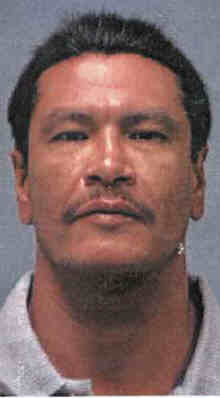 Deaths
which occurred on an August 01: ^top^ Deaths
which occurred on an August 01: ^top^
2002 Roy Ratliff, 37 [photo >], shot twice in the
head by sheriff's deputies, at 13:00, near Lake Isabella, California.
At 01:00, 160 km from there, in the Quartz Hill area outside Lancaster,
California, Ratliff, at gunpoint, had forced Tamara Brooks, 16, out of
the parked Ford Bronco of Eric Joshua Brown (born 01 August 1984), with
whom she was on a date. Ratliff blindfolded Brown, bound him with duct
tape, and tied him to a post. Then he did the same thing with Jacqueline
Marris, 17, and her date, Frank Melero Jr., 19, who were parked in a
pickup truck nearby (tying Melero to his seat in the pickup). Then Ratliff
abandoned the Saturn which he had stolen at gunpoint on 18 July in Las
Vegas from Roberta Young, 64, and her husband James Young, 69, and took
of with the two kidnapped girls in the Bronco. When the Bronco is spotted
off the road in the desert near Lake Isabella, deputies shoot at Ratliff
and rescue the two girls, which he had raped and probably was about to
kill. Ratliff had a criminal record dating to the 1980s in Nebraska and
California that included prison for theft, burglary and possession of
methamphetamines. He disappeared after his parole in July 2001. He was
charged in October 2001 with raping a 19-year-old relative but was never
apprehended.
2002 Shani Ladani, 27, Israeli man tied up and shot in the head
in the morning. A resident of the Olesh moshav in the Sharon area, Ladani
was taken from his place of work, a factory in the Gshuri industrial
zone, at the 1967 Green Line on the Israeli side. Most of the workers
at his factory are Palestinians from Tul Karm and surrounding villages.
2001 Mohammed Sharabati, 35, Palestinian shot by Israelis in Hebron,
West Bank..
2001 Nazem Abu Gharbieh, 47, from Ramallah, and Ahmed Shawkat Salah,
40, from al-Khader, Palestinians suspected of collaboration with
Israel, shot by Palestinians from the “Al Aqsa Martyrs Brigade”.
2000 Du Shugui, 44, executed (presumably
by a bullet to the back of the head) ^top^
He was a policeman in Bazhou,
Hebei province, China. On 04 June 2000, in a argument over a
near-collision, he yelled: "I'm with the public security bureau,
I'm on an errand — and I don't think anyone in Bazhou can
challenge me," drew his service revolver and shot dead a mini-van
driver, an electric company maintenance man. There was a public
outry, touched off by simmering anger against the high-handedness
and brutality of local officials. Du's wife and son, who were
traveling with him at the time of the murder, were sentenced
to seven years and five years in jail for harboring a criminal
after the shooting. |
1988 John Cardinal Dearden, 80, US cardinal
1996 Pierre Claverie, évêque catholique d'Oran, et son chauffeur algérien,
dans un attentat à la bombe commis au domicile de l'évêque.
1982 Unas 120 personas en un fallido golpe de Estado en Kenia.
Son detenidas más de 3000 personas.
1981 Álvaro de Laiglesia, escritor español, director de La
Codorniz.
1969 Miguel Labordeta, poeta español
1966 Ramiro Martinez and 15 others shot from
UT tower by Charles Whitman, driven by brain tumor
^top^
Charles Joseph Whitman, 25, takes
a stockpile of guns and ammunition to the observatory platform
atop a 100-meter tower at the University of Texas and proceeds
to shoot 46 people, killing 16. Whitman, who had killed both
his wife and mother the night before, was eventually shot to
death after courageous Austin police officers, including Ramiro
Martinez, charged up the stairs of the tower to subdue the attacker.
Whitman, a former Eagle Scout
and Marine, began to suffer serious mental problems after his
mother left his father in February 1966. On March 29, he told
a psychiatrist that he was having uncontrollable fits of anger.
He purportedly even told this doctor that he was thinking about
going up to the tower with a rifle and shooting people. Unfortunately,
the doctor didn't follow up on this red flag. On July 31, Whitman
wrote a note about his violent impulses, saying, "After my death,
I wish an autopsy on me be performed to see if there's any mental
disorder." (The autopsy would reveal a brain tumor) The note
then described his hatred for his family and his intent to kill
them. That night, Whitman went to his mother's home, where he
stabbed and shot her. Upon returning to his own home, he then
stabbed his wife to death.
The following morning, Whitman
heads for the tower with several pistols and a rifle after stopping
off at a gun store to buy boxes of ammunition and a carbine.
Packing food and other supplies, he goes to the observation
platform, killing the receptionist and two tourists before unpacking
his rifle and telescope and hunting the people below. An expert
marksman, Whitman was able to hit people as far away as 500
m. For 90 minutes, he continues firing while officers seek a
chance to get a shot at him. By the end of his rampage, 16 people
are dead and another 30 injured. The University of Texas tower
would remain closed for over 30 years before reopening in 1999.
|
1943 Two US sailors as PT-109 sinks; but
JFK and 10 others survive ^top^
A Japanese destroyer rams an
American PT (patrol torpedo) boat, No. 109, slicing it in two.
The destruction is so massive other American PT boats in the
area assume the crew is dead. Two crewmen were, in fact, killed,
but 11 survive, including Lt. John F. Kennedy.
Japanese aircraft had been on
a PT boat hunt in the Solomon Islands, bombing the PT base at
Rendova Island. It was essential to the Japanese that several
of their destroyers make it to the southern tip of Kolombangara
Island to get war supplies to forces there. But the torpedo
capacity of the American PTs was a potential threat. Despite
the base bombing at Rendova, PTs set out to intercept those
Japanese destroyers.
In the midst of battle, Japan's
Amaqiri hit PT-109, leaving 11 crewmen floundering in the Pacific.
After five hours of clinging to debris from the decimated PT
boat, the crew made it to a coral island. Kennedy decided to
swim out to sea again, hoping to flag down a passing American
boat. None came. Kennedy began to swim back to shore, but strong
currents, and his chronic back condition, made his return difficult.
Upon reaching the island again, he fell ill.
After he recovered, the PT-109
crew swam to a larger island, what they believed was Nauru Island,
but was in fact Cross Island. They met up with two natives from
the island, who agreed to take a message south. Kennedy carved
the distress message into a coconut shell: "Nauru Is. Native
knows posit. He can pilot. 11 alive need small boat."
The message reached Lieutenant
Arthur Evans, who was watching the coast of Gomu Island, located
next to an island occupied by the Japanese. Kennedy and his
crew were paddled to Gomu. A PT boat then took them back to
Rendova.
Kennedy was awarded the Navy
and Marine Corps Medal, for gallantry in action. The coconut
shell used to deliver his message found a place in history-and
in the Oval Office. PT-109, a film dramatizing this story,
starring Clift Robertson as Kennedy, opened in 1963. |
1917 Frank Little, IWW organizer, lynched in Butte, MT
1917 Enrique Prat de la Riba, político catalán.
1894 Hugo Frederik Salmson, Swedish artist born on 07 July 1843
or 1844.
1893 Alessandro La Volpe, Italian artist born in 1820.
1882 Henry Kendall, 43, Australian poet, of tuberculosis —
KENDALL ONLINE: Leaves
From Australian Forests — Poems
and Songs: 1862 — The Poems
of Henry Kendall — Songs
From the Mountains
1857 Charles Turner, presumably British artist, born in 1773. — Not
to be confused with THE Joseph
Mallord William Turner [1775-1851] — LINKS
1790 Jacob van Lint, Flemish artist born on 08 February 1723.
1494 Giovanni Santi, mediocre Urbino painter and poet at the court of art
patron prince Frederico da Montefeltre. Giovanni Santi was born in 1435. —
His main claim to fame is that he was the father of Raffaello Santi THE “Raphael”
[06 Apr 1483 – 06 Apr 1520].
|
 On
an August 01:
On
an August 01:  Deaths
Deaths